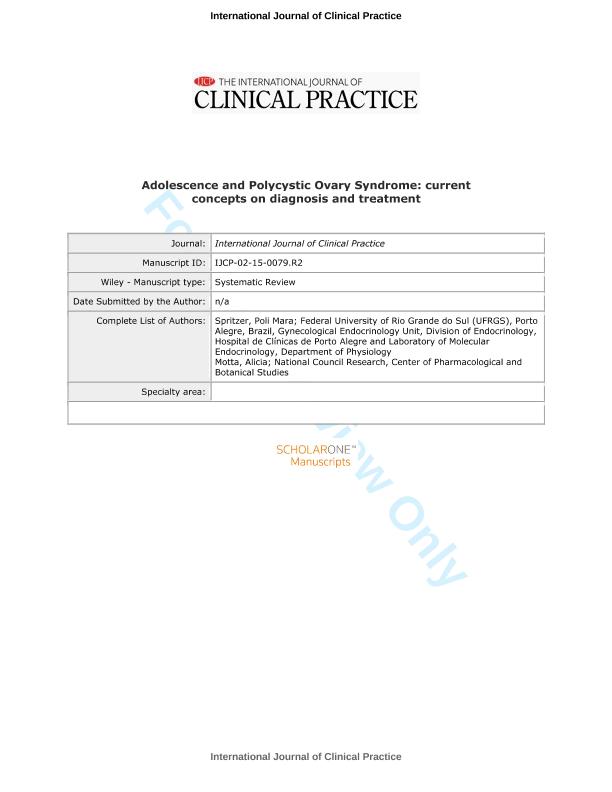Mostrar el registro sencillo del ítem
dc.contributor.author
Motta, Alicia Beatriz

dc.contributor.author
Spritzer, Poli Mara
dc.date.available
2017-03-08T20:06:13Z
dc.date.issued
2015-11
dc.identifier.citation
Motta, Alicia Beatriz; Spritzer, Poli Mara; Adolescence and Polycystic Ovary Syndrome: current concepts on diagnosis and treatment; Wiley; International Journal of Clinical Practice; 69; 11; 11-2015; 1236-1246
dc.identifier.issn
1368-5031
dc.identifier.uri
http://hdl.handle.net/11336/13652
dc.description.abstract
Background: Adolescence is a time characterized by changes in reproductive hormones and menstrual patterns, which makes it difficult to diagnose Polycystic Ovary Syndrome (PCOS) in this population. The diagnosis of PCOS has great physical and psychosocial impact in the young person. Despite the importance of a diagnosis of PCOS at adolescence, data available are limited. Aims: This review focuses on analyzing markers of PCOS diagnosis and possible treatments in adolescence. Results: Although during adolescence diagnosis criteria of PCOS overlap with physiological changes including clinical manifestations of hyperandrogenism (acne and hirsutism,), oligo/amenorrhea, anovulation and ovarian microcysts, there is agreement that irregular menses and hyperandrogenemia should be used to diagnose PCOS in this population. Moreover, considering that PCOS phenotype could change through the reproductive age and that adolescents display heterogeneous ovarian morphology, it has been proposed that diagnosis of PCOS should be confirmed after the age of 18. The first-line treatment for menstrual irregularity and hirsutism are oral contraceptive pills and for obesity and metabolic abnormalities are lifestyle changes. Insulin-sensitizer drugs, such as metformin, may be added to the treatment in the presence of metabolic alterations. Antiandrogen drugs may also be associated for treating moderate to severe hirsutism. Conclusions: During adolescence, physiological changes overlap with signs and symptoms of PCOS; thus the diagnosis criteria should be carefully considered. Regarding the treatment of adolescents with PCOS, non-pharmacological interventions include lifestyle changes. Pharmacological treatments comprise oral contraceptive pills, antiandrogens and metformin, used isolated or combined.
dc.format
application/pdf
dc.language.iso
eng
dc.publisher
Wiley

dc.rights
info:eu-repo/semantics/openAccess
dc.rights.uri
https://creativecommons.org/licenses/by-nc-sa/2.5/ar/
dc.subject
Polycystic Ovary Syndrome
dc.subject
Adolescence
dc.subject
Oligo/Amenorrhea
dc.subject
Anovulation
dc.subject
Cardiovascular Risk
dc.subject
Metformin
dc.subject
Oral Contraceptive Pills
dc.subject.classification
Obstetricia y Ginecología

dc.subject.classification
Medicina Clínica

dc.subject.classification
CIENCIAS MÉDICAS Y DE LA SALUD

dc.title
Adolescence and Polycystic Ovary Syndrome: current concepts on diagnosis and treatment
dc.type
info:eu-repo/semantics/article
dc.type
info:ar-repo/semantics/artículo
dc.type
info:eu-repo/semantics/publishedVersion
dc.date.updated
2017-03-06T17:17:44Z
dc.identifier.eissn
1742-1241
dc.journal.volume
69
dc.journal.number
11
dc.journal.pagination
1236-1246
dc.journal.pais
Reino Unido

dc.journal.ciudad
Londres
dc.description.fil
Fil: Motta, Alicia Beatriz. Consejo Nacional de Investigaciones Científicas y Técnicas. Oficina de Coordinación Administrativa Houssay. Centro de Estudios Farmacológicos y Botánicos; Argentina
dc.description.fil
Fil: Spritzer, Poli Mara. Universidade Federal do Rio Grande do Sul; Brasil
dc.journal.title
International Journal of Clinical Practice

dc.relation.alternativeid
info:eu-repo/semantics/altIdentifier/url/http://onlinelibrary.wiley.com/doi/10.1111/ijcp.12719/full
dc.relation.alternativeid
info:eu-repo/semantics/altIdentifier/doi/http://dx.doi.org/10.1111/ijcp.12719
Archivos asociados
